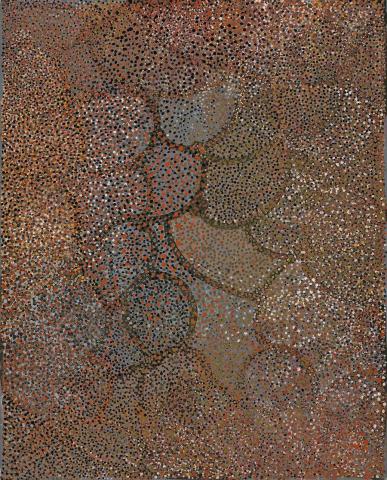UNTITLED, 1990
EMILY KAME KNGWARREYE
synthetic polymer paint on canvas
150.0 x 120.0 cm
inscribed verso: artist's name and Delmore Gallery cat. no. 0L05
Painted at Delmore Downs Station, Northern Territory
Delmore Gallery, Alice Springs
Private collection, United States of America
Private collection, Melbourne
For paintings executed in the same year, in a similar style, see: Yam Tracking, 1990 in Isaacs, J., Smith T., Ryan, J., et.al., Emily Kngwarreye Paintings, Craftsman House, Sydney, 1998, p. 52, pl. 9 (illus.); and Awelye, 1991, in Neale M., Emily Kame Kngwarreye: Alhalkere, Paintings from Utopia, Macmillan Publishers, Melbourne, 1998, p. 42, cat. 45, pl. 25 (illus.)
Emily Kame Kngwarreye began painting on canvas in late 1988 and quickly emerged as one of Australia's leading painters, her works being sought after on an unprecedented scale. Her mark making revealed a strength and sureness of hand that delivered an exuberance of gesture. She developed a free-flowing style of painting based on the meandering line pattern of the spread of the roots of the yam plant underground. This design, and myriad variations upon it, would either dissolve into fields of layered colour achieved through a build up of dots upon dots, or standalone becoming the graphic centrepiece of later works.
This early painting relates to the dry period of the year when the root of the 'alatji' (yam plant) lays dormant underground waiting to be either harvested or rejuvenated by rain. The dotting represents the desert floor, covered in yam leaves and flowers, as well as the dark ripe fruit of the bush plum - a food favoured by emus, thus making the connection between the artist's Yam Women ancestors and the mythological Emu.
Renowned for the expression of ceremony through her art, Kngwarreye painted the spiritual aspect of her life as it relates to country and Awelye or women's ceremonies. Her mark making and abstract references to ritual practice identifies the relationship between individual, country, ceremony and ancestors. Ceremony, as expressed through narrative dance and body decoration reinforces knowledge about staples such as bush foods and water sources, as well as teaching basic social codes and obligations. Through such paintings, Emily passed on her knowledge to those who follow her.
CRISPIN GUTTERIDGE
